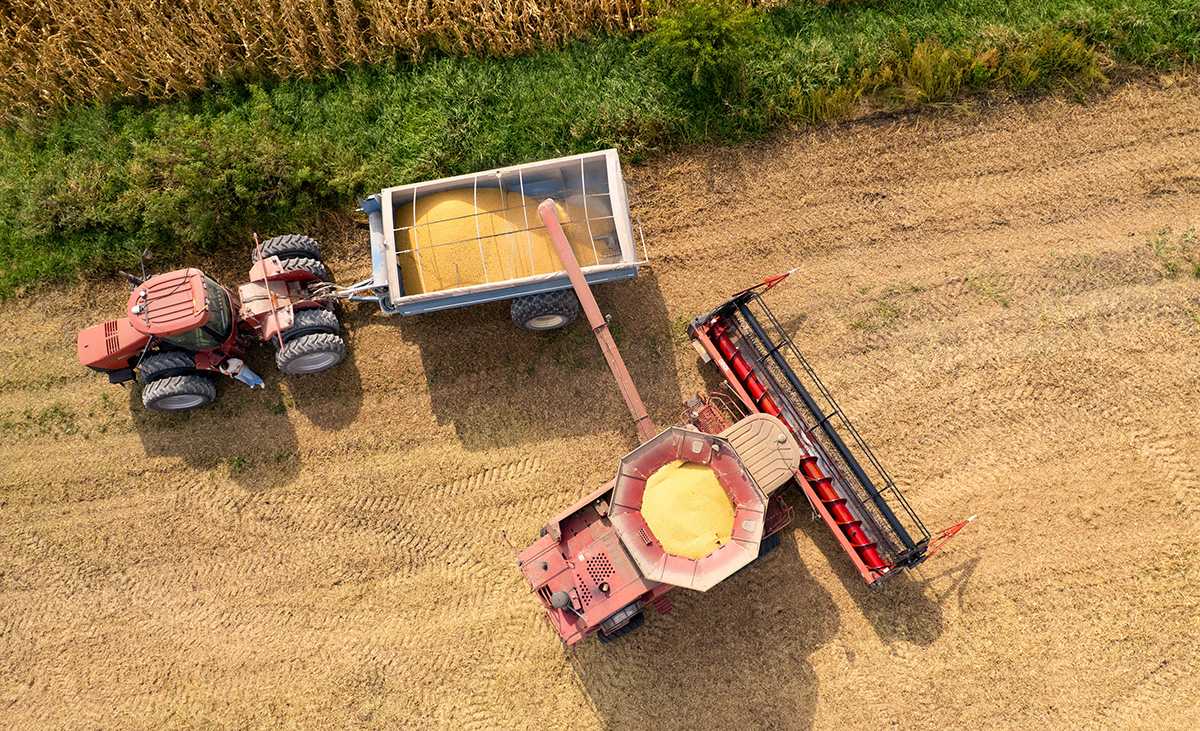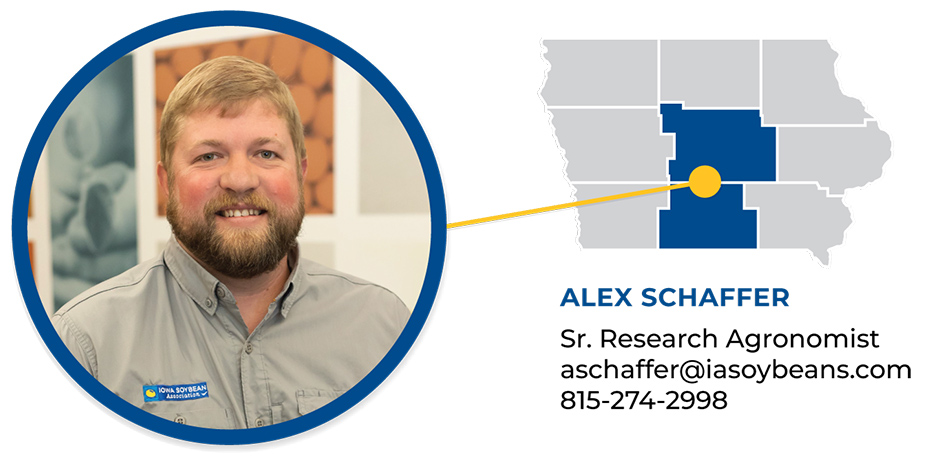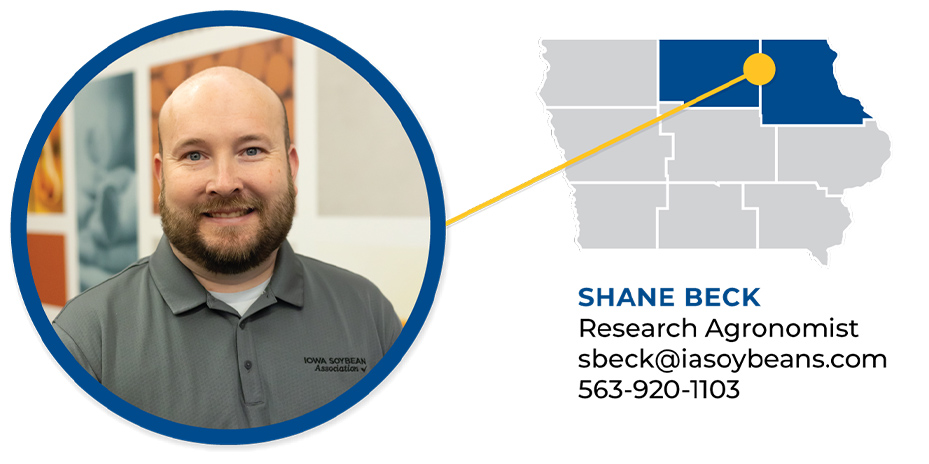
(Photo: Iowa Soybean Association / Joclyn Kuboushek)
Walking Rows 2025: Monitoring soil temps for anhydrous
October 23, 2025 | Kriss Nelson
Looking back on the season, Mother Nature brought a few surprises. Early in the season, wetter-than-normal conditions occurred, then southern winds carried southern rust north, affecting corn, and a dry spell followed just as soybeans were trying to mature.
Iowa Soybean Association (ISA) research agronomists urge farmers to keep a close eye on soil temperatures as many cooperatives begin releasing anhydrous tanks and hitting the fields.
There’s still time to sign up for fall and spring trials. Reach out to your ISA research agronomist for more information.
Alex Schaffer - Central/South Central Iowa
Some farmers have finished harvest, and most others see daylight at the end of the tunnel in central and southern Iowa. I have heard reports of corn yields that vary wildly, and soybean yields have been average to slightly better than average.
What has been most surprising to me, and I think a lot of farmers out there, is how dry the grain got in a big hurry. Dry grain makes for an easy and fast harvest, but I feel that with some of the moisture levels I have been hearing about, corn harvest could have been about finished before October began.

We got a pretty good start to planting right in the middle of April, but it was cool, windy and a little wet to start. This caused things to really slow down, especially no-till soybeans, and that led to sudden death appearing in August.
The corn crop's biggest problem at this stage was likely nitrogen loss due to heavy rains in some areas of the state. I remember the line from Webster to Hardin County getting hit pretty hard in late spring or early summer.
Due to the wet conditions, we thought we would see a lot of disease in our soybean fields, but it didn't materialize. Instead, southern rust blew in with some storms and really took the spotlight from mid-summer on. This led to a lot of fungicide being applied to corn, some of it way too late, and the big yield swings observed from the combine.
Unfortunately for the soybean crop, it did turn a little dry in August and September, taking the top-end yield out of some beans, especially later-maturing varieties that were still trying to fill pods in mid- to late September.
Overall, it was a good season for production and an efficient harvest, but we didn't get exactly what we expected or hoped for in some cases. I think after the season, many farmers will be thinking about what was worthwhile and what wasn't, and what they would do differently if they had a crystal ball. For me, it is keeping in mind basic agronomy, proactively managing your fields and solid recordkeeping that will keep the farm running during times like these.
Shane Beck – Northeast/Northern Iowa
Harvest is winding down across the region. Yields were highly variable this year, with the high rainfall and the disease pressure that moved in at the end of the season, causing a widespread decline in yields across fields and between fields.
Some inputs were also more profitable this year. Fungicide on corn provided significant returns compared to fields that were not sprayed at all, whereas on the soybean side, there was minor difference in yields between areas treated with fungicide and those that were not treated with fungicide.

As we move into post-harvest activities like tillage and fertilizer applications, there are a few key things to remember. When applying anhydrous, we should wait until the soil temperature at a 4-inch depth is 50 degrees and has cooled. This helps prevent the nitrogen from converting into a nitrate that can be leached from the field. Another good practice is to use a nitrogen stabilizer product with the anhydrous. We have data showing a 20–30-bushel difference between strips treated with a nitrogen stabilizer and those without. This difference may not always be so big, but one year's gain can cover the stabilizer cost for several years.
We still have a few trials to fill this fall. The trials we are looking to fill are a phosphorus with strip tilling trail on either corn or soybeans. It compares a product called RhizoSorb by Phospholutions which will be at a 50% rate of normal monoammonium phosphate (MAP) and diammonium phosphate (MAP) compared to a full rate of MAP/DAP. The idea is that the RhizoSorb is more readily available, so it can be applied at half the rate and still see the same results as a full rate of MAP/DAP.
We also have a couple variable nitrogen rate trials with anhydrous. One is looking at the optimal nitrogen rate for your field, and the other is a partnership with Pivot Bio, exploring their new product, PROVEN G3, and how it performs at a few different nitrogen rates.
The last trial we still have a few spots available for is a residue management trial looking at a biological product sprayed in the fall called Meltdown by BW Fusion. This trial examines how the residue breaks down over the following growing season and the nutrients it releases.
Craig Woods – Northwest Iowa
Soybeans are mostly harvested in the west central and northwest portions of the state. Yields range from the low 60s to 80 bushels per acre; however, some fields exhibit significant in-field variability, depending on conditions and challenges throughout the growing season.
Corn is still being harvested, depending on dry down and fungicide applications. Yields are highly variable, with some fields averaging below 200 bushels an acre and some reaching 280 bushels an acre.
When fall approaches and soil temperatures drop, we anticipate better fertilizer application conditions.
We are also looking to hit the ground running with fall research trials.

This year we have two research trials that have or can have a fall variable rate anhydrous component. Both are looking at nitrogen uptake and use efficiency.
The first is a continuation of previous work with Iowa State University and the Iowa Nitrogen Initiative. The Iowa Nitrogen Initiative has been working with farmers since 2022 to help provide data to the N-FACT tool, which is a free online tool that offers probability-based ranges of optimum nitrogen fertilizer rates.
The second being a dive into the use of seed treatments to improve nitrogen use efficiency with Pivot Bio’s new PROVEN G3 seed treatment. In this trial, we'll use variable rate nitrogen applications to test the performance of PROVEN G3 under different levels of nitrogen availability.
For those interested in participating or wanting more information on participating in on-farm research trials with the RCFI team, click here.
Lucas De Bruin - Southeast/Eastern Iowa
Harvest is well on its way to completion in my regions of southeast and eastern Iowa. Yields have been all across the board—lots of variables this year, from hybrid selection to nutrient management to location.
Soybean yields were good, but not great. Soybean success hinged mostly on the weather, regardless of other factors.
Corn yields have been average around here if you sprayed fungicide, lower if you did not. Fungicide showed to pay this year on corn.

A lot of cover crops have shown up with a lot more getting seeded.
Post-harvest is a good time to take a soil sample before any fertilizer gets spread. It also allows you to analyze your fields and see what you need and whether you need it. If you have been sampling in the spring, I would advise that you stay consistent with what you have been doing to make sure the readings are comparable.
Manure application is underway in the area. Hopefully, you stabilized the manure if you are counting on nitrogen credit. Ground temps are still in the mid-50s, a little way to go before biology slows down in the soil.
I presume we will see NH3 going on before the end of the month. That being said, if you are putting on any NH3 and can variable rate it, reach out to your local research agronomist and see what trial fits for you and your farm. The Nitrogen Initiative is an excellent trial to help you navigate nitrogen rates across your farm.
Gathered by Kriss Nelson.
Back